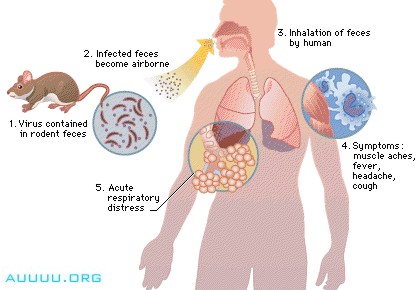The diseases and disorders of the respiratory system can affect any part of the respiratory tract and range from trivial to life-threatening. The nasal passages and pharynx, for example, are targets for the viruses that cause colds. These viruses infiltrate and destroy the cells of the nasal passage membranes. The immune system fights back by increasing blood flow to the area, bringing numerous virus-attacking white blood cells to the scene; this causes the membranes to swell, resulting in the stuffy nose associated with colds. Mucous secretions increase in response to the viral attack, creating the runny nose typical of colds. The infection can spread to the sinuses, the membrane-lined cavities in the head, as well as the lower respiratory tract and the middle ear.

Acute respiratory distress syndrome is one of two human diseases caused by hantavirus. Dust containing virus-infected rodent feces becomes airborne and is inhaled. The virus embeds in the lungs where the infection begins. Flulike symptoms appear in about a week, followed by the collection of fluid and white blood cells in the lungs, causing respiratory failure, then death.
The respiratory system is also subject to allergic reactions such as hay fever and asthma, brought about when the immune system is stimulated by pollen, dust, or other irritants. Hay fever is characterized by a runny nose, watery eyes, and sneezing. It usually occurs seasonally in response to abundant pollen in the air. In asthma, a person has difficulty breathing because the bronchi and bronchioles are temporarily constricted and inflamed. An asthma attack is typically mild, but can be severe enough to be life threatening.
Laryngitis, an inflammation of the larynx, is caused by a viral infection, irritants such as cigarette smoke, or by overuse of the voice. Laryngitis may cause hoarseness, or the voice may be reduced to a whisper until the inflammation subsides. Bronchitis is an inflammation of the membranes that line the bronchi or bronchioles. Bronchitis results from viral or bacterial infection or from irritating chemicals. Infections caused by bacteria or viruses can lead to pneumonia, a potentially serious condition of the lungs in which fluid and inflammation builds up in the alveoli, impeding the flow of oxygen and carbon dioxide between the capillaries and the alveoli.
Tuberculosis is caused by a bacterium that attacks the lungs and sometimes other body tissues as well. If infections in the lungs are left untreated, the disease destroys lung tissue. In the past, antibiotics have controlled tuberculosis, but recently, new antibiotic-resistant strains of the tuberculosis bacterium have evolved. These new strains now pose a significant public health problem.
In emphysema the alveolar tissue is partially destroyed and the remaining alveoli are weakened and enlarge. The bronchioles collapse on exhalation, trapping air in the alveoli. Over time this process impairs the ability to exchange oxygen and carbon dioxide with the circulatory system, leading to breathing difficulties. A noncontagious disease, emphysema results from multiple factors, including a genetic predisposition to the condition, smog, cigarette smoke, and infection.
Lung cancer develops in individuals with a genetic predisposition to the disease who are exposed to cancer-causing agents, such as tobacco smoke, asbestos, and uranium. Cancerous tumors may start in the bronchi, bronchioles, or in the alveolar lung tissue. If lung cancer is detected before the cancer has spread to other parts of the body, treatments are more effective, and the prognosis for full recovery is good. Unfortunately, 85 percent of lung cancer cases are diagnosed after the cancer has spread, and for these cases, the prognosis is very poor.
Respiratory Distress Syndrome (RDS) is the name for a cluster of symptoms that indicate severe malfunctioning of the lungs. In infants, RDS is termed Infant Respiratory Distress Syndrome (IRDS). Commonly found in premature infants, IRDS results when the alveoli fail to fully expand during inhalation. Expansion of the alveoli requires a chemical called surfactant, but in many premature infants, the alveoli are not developed enough to produce this vital substance. IRDS is treated by administering air and surfactant through a breathing tube until the alveoli begin producing surfactant on their own. Adult Respiratory Distress Syndrome (ARDS) results when lungs are severely injured, for example, in an automobile accident, by poisonous gases, or as a response to inflammation in the lungs. ARDS is a life-threatening condition with a survival rate of about 50 percent.


0 comments:
Post a Comment